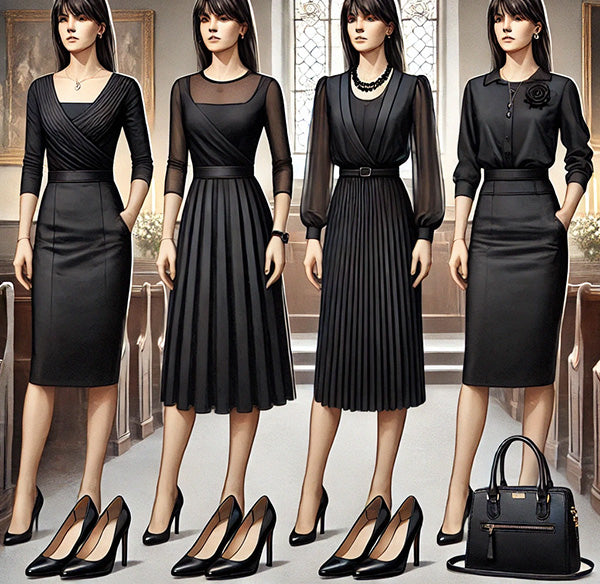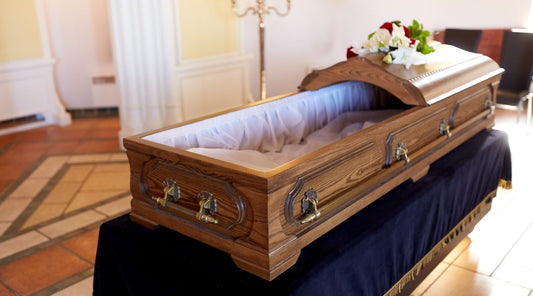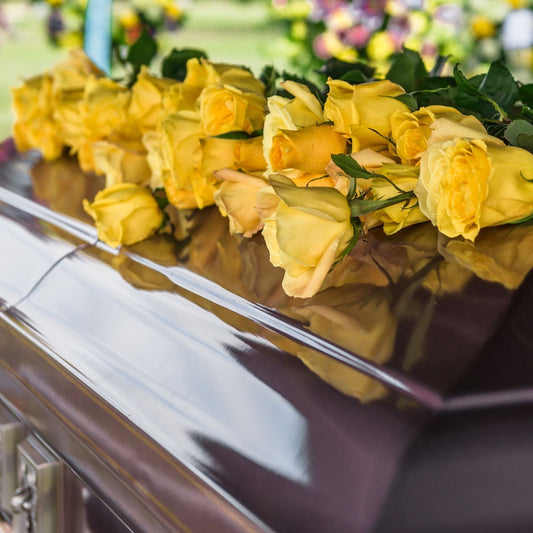
Women's Funeral Attire Guide: Respectful, Cultural & Seasonal Considerations
Dressing appropriately for a funeral is not just about following a dress code; it’s a way to show respect for the deceased and comfort the grieving family. For women, choosing the proper attire for such somber occasions involves balancing tradition, cultural expectations, and personal style. While the primary focus is on expressing respect and reverence, many factors exist, including the type of event, cultural and religious norms, seasonal conditions, and modern trends. This guide offers comprehensive advice on what women should wear to funerals and other end-of-life events, helping you make thoughtful decisions that honor the occasion.

General Guidelines for Women’s Funeral Attire
When attending a funeral, women should opt for attire that is both respectful and understated. Black remains the traditional color for funeral attire, symbolizing mourning and respect. However, dark colors like navy, charcoal, and deep burgundy are also widely accepted. Avoid bright colors and bold patterns, as these can be distracting and may seem disrespectful in a somber setting.
The choice of clothing should lean towards conservative styles. A simple black dress is a classic option, but a dark skirt, blouse, or pantsuit can also be appropriate. The key is to choose garments that are modest—knee-length or longer skirts and dresses, with sleeves that cover the shoulders. Avoid revealing cuts, low necklines, or tight-fitting outfits, as these may be considered inappropriate for the occasion.
Footwear should be formal and practical. Closed-toe shoes, such as black pumps or flats, are ideal. Heels should be moderate in height to ensure comfort, especially if the funeral involves standing or walking for extended periods. Steer clear of casual shoes like sandals, flip-flops, or sneakers, which are generally not suitable for formal occasions.
Accessories should be minimal and tasteful. Simple jewelry, such as stud earrings or a delicate necklace, can complement your outfit without drawing attention. A small black handbag or clutch is appropriate, providing a place to carry essentials discreetly. A dark-colored coat or shawl adds warmth and elegance if the event is outdoors or in colder weather. Though less common today, hats and veils can still be worn, particularly if they hold personal or cultural significance.
Cultural and Religious Considerations
Different cultures and religions have specific expectations for women’s funeral attire, and understanding these nuances is essential to show proper respect.
In Christian funerals, women are generally expected to wear dark, modest clothing. A black dress or a dark suit with a conservative blouse is typically appropriate. Accessories should remain subdued, and excessive jewelry should be avoided to maintain the focus on the occasion.
At Jewish funerals, modesty is of utmost importance. Women should wear clothing that covers the arms and legs, such as long-sleeved dresses or skirts that extend below the knee. A head covering, like a scarf or hat, may also be required, particularly in Orthodox settings. The emphasis is on humility and respect, with black or dark colors being the norm.
Muslim funerals require even more emphasis on modesty. Women should wear loose-fitting clothing that covers the entire body, including the arms and legs. A headscarf, or hijab, is essential, as it shows respect for Islamic customs. Black or dark-colored abayas, long dresses, or tunics paired with trousers are appropriate choices. As with other religions, simplicity and modesty are key.
Hindu funerals present a different set of expectations. White is the traditional color of mourning, so women are usually expected to wear white or light-colored clothing. A white sari, salwar kameez, or a simple white dress is appropriate. Avoid bright colors or elaborate designs, as these are not suitable for the occasion.
Buddhist funerals also emphasize simplicity and modesty. Women should wear plain, dark clothing, typically in black or white. The attire should be conservative, with long sleeves and modest necklines. In some Buddhist cultures, white is preferred as it symbolizes mourning and purity.
Understanding these cultural and religious nuances ensures that your attire is appropriate and respectful, honoring the traditions and beliefs of the deceased and their family.
Seasonal and Weather Considerations
Seasonal and weather conditions should also influence your choice of funeral attire, ensuring that you remain respectful and comfortable.
Opt for lightweight, breathable fabrics like cotton or linen for summer funerals. A simple black dress, skirt, and blouse in these materials can keep you cool while maintaining formality. Sleeveless dresses can be appropriate if they are paired with a shawl or light cardigan to cover the shoulders during the service. Avoid overly casual summer attire like sundresses or flip-flops, as these can be too informal for a funeral setting.
Winter funerals require a more layered approach. A long, dark coat is essential, mainly if the funeral includes an outdoor graveside service. Choose a warm and elegant coat, such as one made from wool or cashmere. Underneath, a dark dress or skirt paired with tights and closed-toe shoes will keep you comfortable and stylish. A scarf, gloves, and a hat in coordinating dark colors can add warmth and sophistication to your ensemble.

Rainy weather presents additional challenges. A waterproof coat or trench in a dark color is a practical choice, ensuring you stay dry without compromising your appearance. Carry a simple, dark-colored umbrella to avoid drawing attention. If the service is outdoors, consider wearing formal and weather-appropriate shoes, such as low-heeled boots or waterproof flats.
For outdoor events, particularly those in unpredictable weather, practicality is essential. Choose shoes that are suitable for the terrain, like wedges or flats that won’t sink into the grass or mud. Layering is also essential, as outdoor temperatures can fluctuate. A dark color cardigan or light jacket can be easily added or removed as needed, keeping your outfit appropriate and comfortable throughout the event.
Attire for Different Types of End-of-Life Events
Different end-of-life events may have varying dress codes, so it’s important to choose your attire based on the specific occasion.
Traditional funerals generally require the most formal attire. A black dress or dark suit with modest accessories is standard. This level of formality reflects the solemn nature of the event and shows respect for the deceased and their family.
Memorial services often allow for slightly more relaxed attire. While still respectful, the dress code can be less formal than a traditional funeral. A dark dress or a skirt and blouse combination is appropriate, but you might have more flexibility in the choice of accessories or the style of your outfit. Consider the setting and tone of the service when selecting your attire.

Wakes and visitations typically strike a balance between formal and semi-formal dress codes. Depending on the time and location, a dark dress or a pair of trousers with a modest blouse may be suitable. The goal is to remain respectful and understated while also considering the less formal nature of these gatherings.
Celebrations of life often encourage a more personalized approach to attire, reflecting the personality and preferences of the deceased. While avoiding anything too casual or bright is important, you may incorporate subtle elements that honor the individual. For example, wearing a scarf in the deceased’s favorite color or a piece of jewelry that has sentimental value can add a personal touch without detracting from the event’s respectful tone.
Virtual funerals, though held online, still require attention to attire. Even though you may be at home, dressing as you would for an in-person service helps maintain the occasion's solemnity. A dark blouse or dress with minimal jewelry ensures you present yourself respectfully on camera.
Modern Trends and Personalization
In recent years, funeral attire for women has shifted towards more personalized and less rigid choices while still respecting the occasion's solemnity. Women now have more freedom to express their style, but it’s crucial to balance this with the event's traditional and respectful nature.
Black remains a staple, but incorporating dark colors like navy, deep green, or burgundy has become more acceptable, offering a way to express individuality subtly. Adding a personal touch, such as a scarf or a brooch that holds sentimental value, can also be appropriate. These small details allow for personalization without overshadowing the event's significance.
However, it's important to maintain a balance. Overly bold patterns or bright colors should be avoided, as they can distract from the purpose of the gathering. If you're unsure, it's safer to err on the side of tradition, sticking with simple, dark clothing that conveys respect.
Cultural sensitivity also plays a crucial role in modern funeral attire. Personalization should not conflict with the family’s cultural or religious traditions. For instance, while a colorful scarf might be a thoughtful tribute at a celebration of life, it could be inappropriate at a traditional Hindu or Muslim funeral where white or black is customary.
By thoughtfully incorporating modern trends and personal touches, you can create an outfit that honors the deceased and the traditions surrounding the event.
Common Mistakes to Avoid
When dressing for a funeral or any end-of-life event, inevitable common mistakes can undermine the respect and solemnity the occasion demands.
Overdressing can be more problematic than underdressing. Wearing a gown or overly formal attire might draw unwanted attention, making you stand out in a setting where the focus should be on the deceased and their family. On the other hand, dressing too casually, such as wearing jeans, a casual sundress, or an overly relaxed outfit, shows a lack of consideration for the gravity of the event.
Inappropriate color choices are another frequent mistake. Bright colors, flashy patterns, and excessive embellishments can be distracting and may come across as disrespectful. It's essential to stick to dark, muted tones that reflect the somber nature of the occasion.
Over accessorizing is another common pitfall. While jewelry and accessories can complement your outfit, they should remain understated. Large, flashy pieces or an abundance of accessories can detract from the simplicity and reverence that funeral attire should convey.
Ignoring the family’s specific requests is a serious misstep. If the family has asked attendees to wear a particular color or follow a specific dress code, respecting these wishes is essential. Disregarding such requests not only disrespects the family but also disrupts the unity and harmony of the event.
By avoiding these common mistakes, you can ensure that your attire is appropriate, respectful, and in keeping with the occasion's solemnity.





